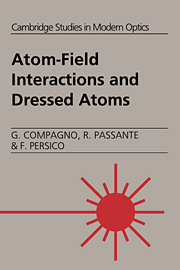Book contents
- Frontmatter
- Contents
- Preface
- 1 The classical electromagnetic field in the absence of sources
- 2 The quantum electromagnetic field in the absence of sources
- 3 The quantum matter field
- 4 Electrodynamics in the presence of sources
- 5 Atoms dressed by a real e.m. field
- 6 Dressing by zero-point fluctuations
- 7 Energy density around dressed atoms
- 8 Further considerations on the nature of dressed states
- Appendix A Multipolar expansion for the vector potential
- Appendix B Electric polarization and magnetization of the Schrödinger field
- Appendix C Rayleigh-Schrödinger perturbation theory
- Appendix D Sum rules for the nonrelativistic hydrogen atom
- Appendix E From Gauss system to SI
- Appendix F Gauge invariance and field interactions
- Appendix G Dressed sources in relativistic QED and in QCD
- Appendix H The energy-momentum tensor and Lagrangian density
- Appendix I The dressed relativistic hydrogen atom
- Appendix J The nonrelativistic Lamb shift in a hydrogenic atom
- Index
4 - Electrodynamics in the presence of sources
Published online by Cambridge University Press: 12 November 2009
- Frontmatter
- Contents
- Preface
- 1 The classical electromagnetic field in the absence of sources
- 2 The quantum electromagnetic field in the absence of sources
- 3 The quantum matter field
- 4 Electrodynamics in the presence of sources
- 5 Atoms dressed by a real e.m. field
- 6 Dressing by zero-point fluctuations
- 7 Energy density around dressed atoms
- 8 Further considerations on the nature of dressed states
- Appendix A Multipolar expansion for the vector potential
- Appendix B Electric polarization and magnetization of the Schrödinger field
- Appendix C Rayleigh-Schrödinger perturbation theory
- Appendix D Sum rules for the nonrelativistic hydrogen atom
- Appendix E From Gauss system to SI
- Appendix F Gauge invariance and field interactions
- Appendix G Dressed sources in relativistic QED and in QCD
- Appendix H The energy-momentum tensor and Lagrangian density
- Appendix I The dressed relativistic hydrogen atom
- Appendix J The nonrelativistic Lamb shift in a hydrogenic atom
- Index
Summary
Introduction. In the previous chapter we have obtained the form of the coupling between matter and the electromagnetic field. We are thus in a position to treat electrodynamics in the presence of charges and currents. We start by obtaining the Euler-Lagrange equations of the matter-electromagnetic field system. These turn out to be the Maxwell-Lorentz equations, which is a set of coupled equations of motion in which the matter field acts as a source for the electromagnetic field and vice versa. In Section 4.2 we derive the Hamiltonian of the complete system in the Coulomb gauge, and this leads to the so-called minimal coupling Hamiltonian, containing both the electromagnetic potential and the matter-field amplitude. Specializing the nonrelativistic matter field to the case of a neutral atom, consisting of the field of electrons in a static nuclear potential, in Section 4.3 we obtain the atom-photon Hamiltonian in the minimal coupling scheme. Some of the basic processes induced by the atom-photon interaction part of the Hamiltonian are also discussed in this section. This gives us the possibility of introducing at this stage a fundamental simplification of the interaction Hamiltonian, namely the electric dipole approximation. The minimal coupling scheme, however, is not the only possible atom-field coupling.
Information
- Type
- Chapter
- Information
- Atom-Field Interactions and Dressed Atoms , pp. 81 - 113Publisher: Cambridge University PressPrint publication year: 1995
